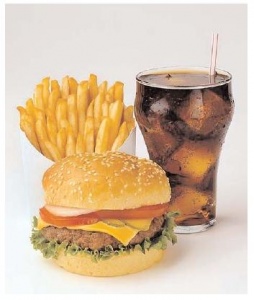June 8th, 2011 by PJSkerrett in Health Tips
No Comments »


The crumbling Food Pyramid and its hip successor (MyPyramid) fell into oblivion yesterday, eroded by the stinging winds of science. Their replacement? A quartered plate called—wait for it—MyPlate that was designed to visually convey the elements of healthy eating to Americans of all ages.
The new icon consists of a white plate divided into four segments: green for vegetables, red for fruits, orange for grains, and purple for protein. Dairy has a prominent place, sitting where a glass of water should be. The hope is that the plate will nudge Americans away from meals dominated by meat and starch and towards meals made up mostly of plant-based foods.
The original Food Guide Pyramid debuted in 1992. It was built on shaky scientific ground. Over the next few years, research from around the world chipped away at the healthy eating message in the pyramid’s base (refined carbohydrates), the middle (meat and milk), and the tip (fats).
The Pyramid got an extreme makeover in 2005. Read more »
*This blog post was originally published at Harvard Health Blog*
April 17th, 2011 by ChristopherChangMD in Health Tips, Video
1 Comment »

The Doctors TV show actually produced a great (and accurate) segment on a relatively new procedure called sialendoscopy. This procedure allows a surgeon to remove a stone that may be blocking your spit gland from draining saliva into the mouth. This is analogous to a kidney stone which blocks urine from draining from the kidney into the bladder resulting in painful swelling of the kidney (causing flank pain).
How does a person know if they have a salivary gland blockage due to a stone? There is a painful swelling located right in front and/or below the ear if the parotid gland is affected, or under the jawbone if the submandibular gland is blocked.

If the blockage persists long enough, it may lead to an infection of the gland itself (sialadenitis). Read more »
*This blog post was originally published at Fauquier ENT Blog*
November 4th, 2008 by Dr. Val Jones in Health Tips, True Stories
4 Comments »
I’m grateful to the Happy Hospitalist for pointing out that color matters when it comes to food consumption. As it turns out, blue light can be an appetite suppressant. And I actually know about this first hand.
I helped to design a research study in connection with Architectural Digest and the Parsons School of Design several years ago. I was a volunteer instructor for a hospital design course in NYC, and wanted to show the students that lighting could influence eating patterns. As it happened, there was a big gala event at a local convention center, and so I worked with my friend Shashi Caan to set up three identical rooms bathed in three different colored lights (yellow, blue, and red).
We had all the gala attendees dress up in white bunny suits (you know, the kind you let patients wear in the OR) and shuttled them through the 3 rooms at regular intervals. The rooms could each hold about 40 guests and copious identical hors d’oeurves were offered.
Guess what we found? The most food was consumed in the yellow room, followed by red, and then a distant third was blue. About 33% fewer snacks were consumed in the blue room during the event (and yes we controlled the number of people in each room so they’d be equal). I found this quite fascinating, but unfortunately never published the results. You see, I didn’t receive IRB approval for any of it.
But the experiment did leave an indelible impression on my mind. As I thought about it, I realized that most fast food restaurants have yellowish interiors. From the golden arches to the lighting – companies like McDonald’s probably recognized (long before I did) that color influences purchasing and eating behavior.
Yep, I’m late to this party – and I’m not painting my kitchen yellow.















